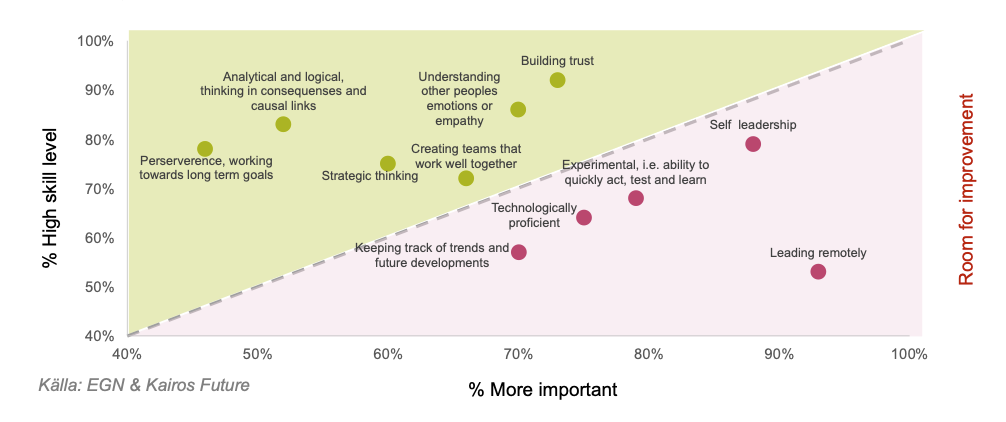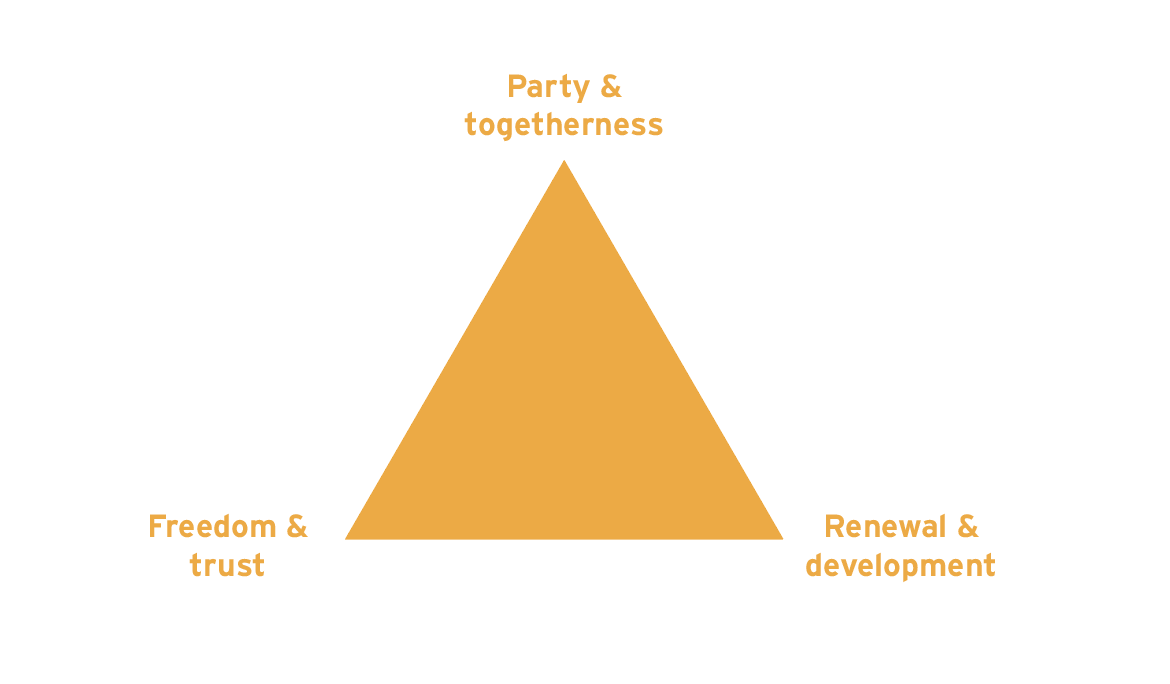What's NXT: These are the five challenges leaders must know for the future of work
The last few years have seen a series of uncertainties in the world of work. Digital disruption was followed by a pandemic and in its aftermath, the leadership in organizations worldwide must deal with an increasingly hybrid work life. At the same time, growing sustainability requirements and a rocky labor market combined with a war in Ukraine is setting the stage for a turbulent world that disturbs supply chains and creates anxiety among both customers and employees.
How should a leader think and act in such turbulent times as these? Most would argue the idea of how we will work in the future is yet to be defined. Leading in stability is one thing. To do so in turmoil is quite another. The priority is to not become stressed or obsessed about the present but rather to stop, look up, reassess, and try to get a sober view of the situation: zoom-out. Find a new platform for your own leadership.
Together with EGN (Executives Global Network), we at Kairos Future have recently conducted a study with more than 2,000 leaders in Western Europe. In it we focused on leadership in the future of work. The responses have provided us with a very interesting picture of the future of work and what leadership will require to succeed. For example, two thirds of top-level managers believe that organizing, controlling, and leading will be significantly more difficult in a distance-based world.
Based on the trends we are seeing and the results of the survey of Western European leaders, we think a number of challenges await leaders in the future. We have chosen to focus on five of the most pressing ones:
1. Innovation requires a reboot – and people on the ground
Innovation may be a worn-out word, but it's something that many still struggle to make work smoothly. 80% of the leaders in the survey say that one of the biggest challenges in the coming years is to increase the capacity for innovation and experimentation. It's about processes and systems that gear up and enhance innovation. The art of systematic innovation will simply be a cornerstone of future working life.
It seems the innovation challenge is greater now than before the pandemic, as several studies carried out during the end of the pandemic show that innovation was the single factor of production most negatively affected during the pandemic.
In many organizations, this resulted in – if not a standstill – then at least a sharp slowdown in innovation. One of the main reasons for this, according to all the studies, is the lack of spontaneous interaction and the absence of the dynamics that are created when people are in the same physical space compared to a teams meeting. While there are examples of organizations that have kept innovation alive through optimized and well-executed digital processes, they are among the exceptions.
Therefore, a key challenge for leadership in the future of work will be to reboot and simultaneously take their innovation processes to a new level compared to the pre-pandemic era.
It is about creating a good idea-generating environment, ensuring that organization and leadership stimulate and engage with "disruptive" signals that generate new ideas – crucial ingredients in innovation. This requires conscious and thoughtful leadership – leadership that puts innovation first and motivates employees and partners to help generate ideas that take the organization to new heights.
2. The double attraction challenge – the manager as social orchestra leader
Attracting new employees is a key challenge for companies and organizations alike. The factor that often tops the list when young adults in particular are asked about attractive employers is the social situation at work. Friendly colleagues and a competent superior – that is, an engaging manager who cares – are central to their vision of the good workplace. This has been well known for a while now. But it is still not enough to attract the new talent. You also need to attract back the old foxes.
Many managers are currently struggling with attracting employees back to the office. The challenge is often greatest for those employees who have become accustomed to a remote existence where less time for commuting and more time for family and personal interests is much appreciated. Getting those "home-bound" employees to return to the office without leaving them feeling obligated to is a tough nut to crack.
One solution to this is usually to motivate with a solid why rather than use coercion. "We need you here" is a much nicer starting point than "we've decided that everyone should be on site". Most leaders therefore need to work more actively to create the social melting pot that is usually the main reason for people wanting to go into the office. The old saying "people attract people" still applies. In times of unrest – at the time of writing the war in Ukraine dominates the zeitgeist – it is also important to ensure that there are social environments in which employees can vent their concerns on a deeper level.
Our view is that it will take a little extra to get those social situations going. Every self-respecting organization needs a 'party fixer' who not only makes sure there is a nice venue and refreshments, but also actively catalyzes social interaction so that 'it's a fun party'. And not just once a year when there is a real staff party but that party opportunities are created on an ongoing basis, i.e. that the office exudes an aura of joy and sharing rather than a hyper-efficient production environment.
3. Borderless management – the art of managing a multidimensional hybrid life
More or less all leaders in the study (93%) responded that the ability to manage remotely is a huge challenge for leadership in the future workplace – both for themselves and for the organization as a whole. At the same time, it is by far the single most important factor to develop personally according to the leaders in the EGN survey.
This suggests that the hybrid life many have talked about is not just talk but is becoming the new normal. The responses from the leaders in the study also show that most agree that it is enough for employees to be on site 2-3 days a week. Another sign is that half of the top managers say they are open to recruiting employees who work remotely for a large part of the time, even if it is much more difficult to recruit such people to their own organization. There is a real shift underway, and we cannot stress enough the importance of finding our own approaches to it.

Graph showing leaders' assessment of the gap between their current capabilities and the future demands on their own leadership. The pink field shows the areas with clear development needs.
4. Lead yourself to lead others to lead themselves. Together with others.
For the past several years we’ve seen a clear trend in leadership centered around the idea of "self-leadership". It generally refers to the ability to lead oneself without the support of detailed clear instructions. Along with the ability to lead at a distance, it is the single most important development factor identified by the leaders in the EGN study for the years ahead. But self-leadership is not just the ability to lead oneself. It is also about being able to lead others so that they can manage their own self-leadership.
Some would say that this is nothing new and that it even has a whiff of the emperor's new clothes about it. Especially in Sweden, with our long tradition of self-motivated and responsible employees who live a working life based on a high level of trust, self-leadership has long been one of the foundations of working life. But that said, the voices heard from the leaders in the survey cannot be dismissed.
The emerging work life requires self-leadership in a new context compared to that of the past. Self-leadership in stable times with clear basic tasks is one thing. Self-leadership in a hybrid life, full of uncertainties and changing conditions is another. Not infrequently, futureproofing the road ahead requires employees and organizations to work even more closely together – with self-leadership as the foundation. Leadership in the workplace of the future will therefore be about a multi-faceted challenge: "From lead yourself to lead others to lead yourself together with others in groups"!
5. Leading in uncertainty: get your head up and let go of the specialists
Eight out of ten leaders in the EGN survey believe that the world is changing faster and faster and that the future is becoming increasingly difficult to predict as uncertainties increase. This is something we at Kairos Future have been banging on about for a long time, and we are pleased to see that recognition of the importance of addressing these issues is increasingly high on the agenda among today's top leaders.
The uncertain fundamentals mean that it is not enough to recycle the same solutions that worked well in stable times. Instead, it is important to review one's own toolbox and ensure that the organization and its leadership have the right instruments to deal with genuine uncertainties. An important foundation is to create an approach that is more about "how could it be" rather than "this is how it will be".
A cornerstone of managing uncertain times is the ability to quickly gain an overview in complex circumstances. The key is to try to keep a cool and to raise your perspective.
It's about finding connections between different arenas and logics rather than digging deeper into areas you already know. In practical terms, leaders in these situations often benefit more from broad generalists than qualified specialists in narrow areas.
Therefore, a key capability of the future workplace will be to create an organization where the ability to think in an exploratory and inquisitive way is rewarded. Making room for people who raise difficult points that often contain truths need to be heard – even though they disrupt normal production. This, in turn, requires a confident and courageous leadership that allows and affirms the different ideas of the team. It is also about finding tools that ensure access to relevant facts and data in areas that are not normally part of one's own radar system and scouting areas.
Three keys to leadership in the workplace of the future
Finally, we would like to share three keys that we believe will help solve the practical leadership issues in this emerging new world of work:
Think "party and togetherness"
Life in the office must attract people and make them want to be there. Both remote employees, new talent and strategic partners who contribute to their own success. Assume that as a leader, you need to organize stimulating dinners (metaphorically) rather than socializing for brief moments at the coffee machine.

Think "freedom and trust"
The future of work will require leaders and employees to be even more able to manage themselves, where they are. This in turn will require freedom and trust from you as a leader. Give freedom but don't let people off the hook, make sure you are there as a safe haven.
Think "renewal and evolution"
The importance of innovation and openness to new paths is absolutely fundamental in times of great uncertainty. It is easy to lose sight of this and want to crawl into a safe corner when the winds are blowing. But those who best stimulate renewal are those who take the greatest leaps forward during a stormy time. With the right strategy and leadership at their core.
Want to know more about the leadership of the future or the study we conducted among 2,000 leaders in Western Europe with EGN? Contact Erik Herngren.
